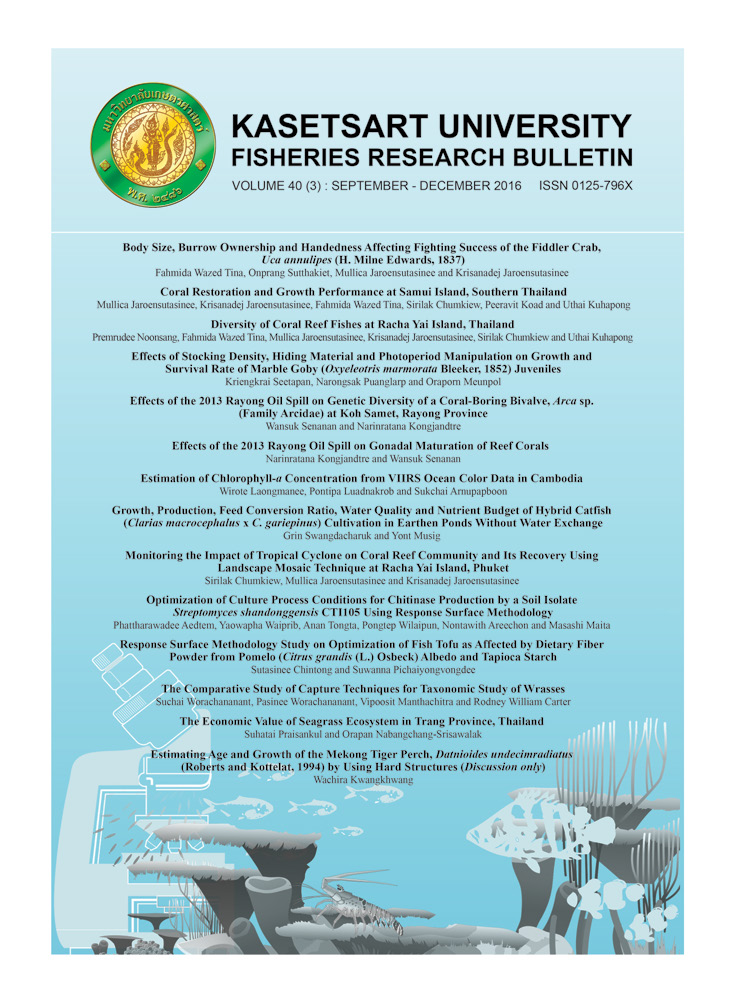Monitoring the Impact of Tropical Cyclone on Coral Reef Community and Its Recovery Using Landscape Mosaic Technique at Racha Yai Island, Phuket
Main Article Content
Abstract
Coral reef ecosystems are being degraded through multiple disturbances that are becoming more frequent and severe. This study examined storm impact on coral reef and its recovery using landscape mosaics technique. This technique demonstrated an off-the-shelf underwater camera and the Adobe Photoshop software, end-users in developing countries with limited resources could use the video mosaics technique for reef monitoring and documenting storm impacts. The landscape mosaic technique was used to document the tropical storm impact on coral communities at Racha Island within 3-5 m of water depth. This video-mosaic method provided a spatially landscape view of the reef benthos. The images from the landscape mosaic method revealed that after the storm on November 2012, 20% of the coral cover disappeared within the first month and continued to die off within the six month after the storm. Two years after storm, the results from the images still revealed some slightly increases in the percentage of coral cover but not significant. Most of the coral destroyed by the storm were foliaceous coral - i.e. Montipora sp. This study clearly demonstrates that the physical disturbance on coral reef, community changes and its recovery can be monitored using the two-dimensional landscape mosaic technology.
Article Details
References
2. Bouchon C.,Y. Bouchon-Navaro, D. Imbert, and M. Louis. 1991. Effets de l'ouragan Hugo sur les communautes cotieres de Guadeloupe (Antilles Francaises). Annales de ITnstitut Oceanographique, Paris. 67: 5-33.
3. Chumkiew S., M. Jaroensutasinee, and K. Jaroensutasinee. 2011. Impact of Global Warming on Coral Reefs. Walailak Journal of Science and Technology. 8(2): 111-129.
4. Gardner T.A., l.M. Cote, J.A. Gill, A. Grant, and A.R Watkinson. 2005. Hurricanes and Caribbean coral reefs: impacts, recovery patterns, and role in longterm decline. Ecology.86: 174-184.
5. Gleason C.R.A., D. Lirman, D. Williams, N.R Gracias, B. Gintert, H. Madjidi, R.P. Reid, G.C. Boynton, S. Negahdaripour, M. Miller, and P. Kramer. 2007. Documenting hurricane impacts on coral reefs using two dimensional video-mosaic technology. Marine Ecology. 28: 254-258.
6. Grauss R.R., I.G. Macintyre, and B.E. Herchenroder. 1984. Computer simulation of the reef zonation at Discovery bay, Jamaica: hurricane disruption and long-term physical oceanographic controls. Coral Reefs. 3: 59-68.
7. GrinstedA., J.C. Moore, and S. Jevrejeva. 2013. Atlantic hurricane surge threat from rising temperatures. Proceedings of the National Academy of Sciences of the United States of America. 110: 5369-5373.
8. Harmelin-Vivien M.L. 1994. The effects of storms and cyclones on coral reefs: a review. Journal of Coastal Research Special Issue: Coastal Hazards. 12: 211-231.
9. Jaroensutasinee M., K. Jaroensutasinee, T. Fountain, M. Nekrasov, S. Chwnkiew, P. Noonsang, U. Kuhapong, and S.J. Bainbridge. 2011. Coral sensor network at Racha lsland, Thailand. Proceeding of the Environmental Information Management conference (EIM). p. 82-86.
10. Jaroensutasinee K., M. Jaroensutasinee, S. Bainbridge, T. Fountain, S.J. Holbrook, and M. Nekrasov. 2012a. CREONIntegrating disparate sources of remote coral reef sensor data. Proceedings of the 12th International Coral Reef Symposium (ICRS). p. 96.
11. Jaroensutasinee M., K. Jaroensutasinee, S.J. Bainbridge, T. Fountain, S. Chumkiew, P. Noonsang, U. Kuhapong, S. Vmmarat, A. Poyai, and M. Nekrasov. 2012b. Sensor network applications for reefs at Racha Island, Thailand. Proceedings of the 12th International Coral Reef Symposium (ICRS). p.95.
12. Jaroensutasinee K., S. Chumkiew, and M. Jaroensutasinee. 2015. Applying a landscape mosaics technique to detect tropical cyclone impacts on coral reef community. Indian Journal of Geo Marine Sciences. 44(7): 1017-1024.
13. Knowlton N., J.C. Lang, M.C. Rooney, and P. Clifford. 1981. Evidence for delayed mortality in hurricane-damaged Jamaican staghom corals. Nature. 294: 251-252.
14. Lugo-Fernández A., and M. Gravois.2010. Understanding impacts of tropical storms and hurricanes on submerged bank reefs and coral communities in the northwestern Gulf of Mexico. Continental Shelf Research. 30: 1226-1240.
15. Mah A.J., and C.W. Steam. 1986. The effect of Hurricane Allen on the Bellairs fringing reef, Barbados. Coral Reefs. 4: 169-176.
16. Manzanello D.P., M. Brandt, T.B. Smith, D. Linnan, J.C. Hendee, and R.S. Nemeth. 2007. Hurricanes benefit bleached corals. Proceedings of the National Academy of Sciences of the United States of America. doi:10.1073/pnas. 0701194104.
17. Massel S.R, and T.J. Done. 1993. Effects of cyclone on massive coral assemblages on The Great Barrier Reef meteorology, hydrodynamics and demography. Coral Reefs. 12: 153-166.
18. McClanahan T., N. Polunin, and T. Done. 2002. Ecological states and the resilience of coral reefs. Conservation Ecology. 6: 18.
19. Oliver J., G. Déath, T. Done, D. Williams, M. Furnas, and P. Moran. 1995. Longterm monitoring of the Great Barrier Reef Status Report No. 1. (Australian Institute of Marine Science, Townsville). pp. 121.
20. Park Y.H., and Suh K.-D. 2012. Variations of storm surge caused by shallow water depths and extreme tidal ranges. Ocean Engineering. 55: 44-51.
21. Phongsuwan, N. 1991. Recolonization of a coral reef damaged by storm on Phuket Island, Thailand. Phuket Marine Biological Center Research Bulletin. 56: 75-83.
22. Rogers C.S. 1993.Hunicanes and coral reefs: the intermediate disturbance hypothesis revisited. Coral Reefs. 12:127-137.
23. Stoddart D.R. 1963. Effects of Hurricane Hattie on the British Honduras reefs and cays, Oct. 30-31, 1961. Atoll Research Bulletin. 95: 1-142.
24. Treml E., M. Colgan, and M. Keevivan. 1997. Hurricane disturbance and coral reef development: a geographical information system (GIS) analysis of 501 years of hurricane data from the Lesser Antilles. Proceedings of the 8th International Coral Reef Symposium. 1: 541-546.
25. Yu K., J. Zhao, G. Roff, M. Lybolt, Y. Feng, T. Clark, and S. Li. 2012. High-precision U-series ages of transported coral blocks on Heron Reefs (southern Great Barrier Reef) and storm activity during the past century. Palaeogeography, Palaeoclimatology, Palaeoecology. 337-338: 23


